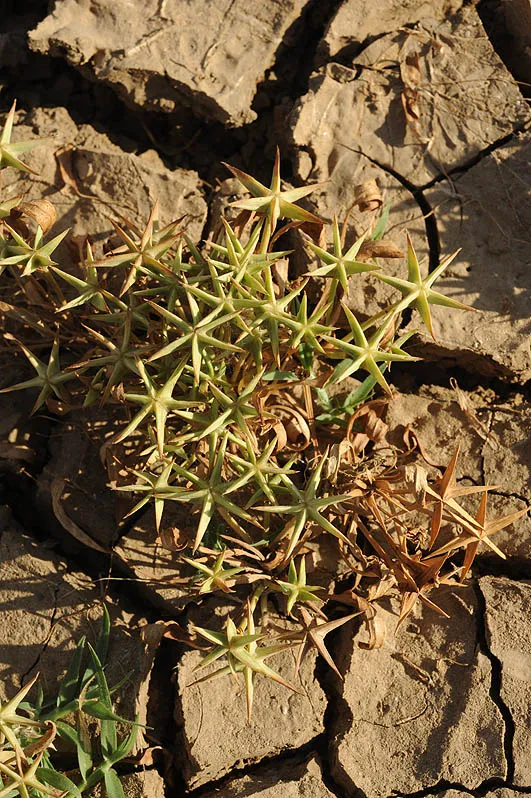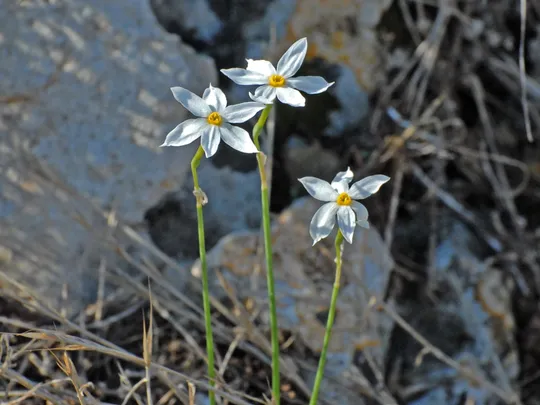Common Water Plantain, European Water Plantain
Alisma plantago-aquatica

Alisma plantagoaquatic
now grows only in the Dan Valley, which is in the northern Hula Valley, and in
the past too, it was distributed only in the Hula region. It now grows in the Nuhela
springs – En Barid and En Div, and rivulets (now artificial canals) that stem
from them and are collected in the Nuhela Canal north of Tel Dan. A.
plantagoaquatica was also observed in 1987 in the Tel Dan Reserve, but it
was absent from there in 1972-1973 (Schmida and Lev Ari, 1974). Yariv Yvri
(1968) found the plant at En
Qiniye at an altitude of 730
meters, at the foot of Mount Hermon, but it is extinct from there since 1987 when
the spring waters were exploited. Mike Livneh found a small population in a tributary
of the Hermon stream on the Banias Plateau.
Before the draining
of the Hula, there were additional A. plantagoaquatic
sites in the area: Tslahya Pond near Kibbutz Kfar Blum, Enan Stream (= Malaha) on
the western edges of the Hula. These collections, conducted in 1941-1952,
indicate that the species was probably common on the margins of the Hula Marsh.
Alisma plantagoaquatica
grows in marshes, pools, reservoirs and streams with cold clear shallow water, as
well as in standing water and slow-flowing water.
The genus Alisma includes nine
species, common in the temperate regions of the Northern Hemisphere. All have
thick rhizomes, and the base of their leaves is
submerged in water. Germination takes place when the water level descends; thus,
the stands in the water are created by vegetative spreading from the pool edges
and/or rarely by seed germination when the pool dries. In the Middle East,
there are three species, all of which grow in Israel. A.
lanceolatum is the most common species in Israel of the three, but its
populations are also showing an alarming decrease. There is a great overlap
between the distribution of the A. plantagoaquatica and that of
the A. lanceolatum,
but the latter is more sensitive to cold, thus it does not grown in
northern Europe, and is more prevalent in the Mediterranean countries.
The small flower is probably adapted
for self-pollination, wind pollination, and particularly insect pollination (Yvri,
1988). The probability of mutual pollination between Alisma plantagoaquatica and
A. lanceolatum is reduced due to their different flowering hours during the
day (the flowering time of A. lanceolatum is some two hours earlier than
that of A.
plantagoaquatica). Its pollinators are honeybees,
small wild bees, flies and beetles.
·
Alisma plantagoaquatica is a very rare plant
that grows at only four sites, all close together, in the Dan Valley in the northern
Hula Valley.
·
The
only large population with more than tens of plants exists (true for summer
2004) only at En Barid (Nuhela springs). At other
sites the number of plants is very small.
·
Despite
the Nuhela springs having been declared as a reserve, there is intensive
grazing at the site, and in the summer of 2004 all the plants were eaten and trampled
and unable to blossom and bloom.
The Alisma plantagoaquatica
population at the Nuhela Springs should be fenced, monitored and strictly protected.
The species should be reintroduced to the Hula and to the springs around it, such
as the Enan Stream.
The distribution of Alisma
plantagoaquatic is almost cosmopolitan: throughout Europe and the
Mediterranean countries, the Black Sea countries and North America; in Asia – India, Pakistan,
Afghanistan, Central Asia and all the western and eastern areas of Siberia; in Africa – in the countries of the Maghreb, Ethiopia,
Tanzania and Egypt; in the Middle East, the species grows in Egypt’s Nile Delta,
in Israel and in Jordan (probably extinct in the Gilead), in western Syria-Lebanon,
in most regions of Turkey, in northern Iran and southern Iraq. In recent generations,
the plant was introduced to South America, Australia, South Africa, and New
Zealand.
Alisma plantagoaquatica
is a plant whose lower part is submersed in water, with beautiful leaves and a
large and extensive inflorescence, which is attractive to cows and slightly to
humans also. It is a northern species that grows only in the northern Hula
Valley. Its populations have significantly declined since the drainage of the Hula.
The four surviving sites are adjacent to one other and the largest single
population, at the Nuhela Springs, suffers greatly from cattle grazing and trampling.
עברי, י. 1988. כף-צפרדע בישראל. רתם 28: 51-60.
Current Occupancy Map
| 1000 squre meter pixel | 5000 squre meter pixel | 10000 squre meter pixel | |
|---|---|---|---|
| number of observations | 0 | 0 | 0 |
| in total pixels | 0 | 0 | 0 |
| Family | Alismataceae |
| Classification | On the endangered species list |
| Ecosystem | Mediterranean humid |
| Chorotype | Multi-regional , Centered in Euro - Siberian |
| Conservation Site | Nuhela springs |
| Rarity |
1
4
6
|
|---|---|
| Vulnerability |
0
3
4
|
| Attractiveness |
0
2
4
|
| Endemism |
0
0
4
|
| Red number |
1
5.8
10
|
| Peripherality | N |
| IUCN category | DD EW EX LC CR EN VU NT |
| Threat Definition according to the red book | Critically endangered |
 Based on:
Based on:






